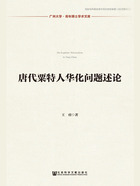
Abstract
Sogdians’ characteristics in Tang China were reflected in cultural etiquette and custom,religious belief,settlements,political post and occupations,with sinicization the main part and Western hu and Türk the sub-cultures. Sogdians’s sinification began with taking their kingdom names as the person names when entering into China. On the one hand,the form of 3-character,refined hu names and the name reflecting the Taoist doctrine constitute the main-stream trend of sinicization. For instance,the scene of a dog trifling with and a deer recorded in Tang Shu,which has nothing to do with the Zoroastrism funeral ritual but relates to Han people’s auspicious sign. On the other hand,hu features were well-preserved in various forms,taking Sogdians names of Turfan documents for example,we’ve found the Zoroastrianism and buddhist elements of central Asia and India. Nine hu names like Kang and An have several sources. If he/she who has no hu traits,we can not infer that they are Sogdians’ posterity. But the pan-Sogdians’ problems were made more complicated because many Sogdians laid a false claim to they came from noble families. The passage Anappended is on the race of Yuan zhen’s concubine,which is a good example to illustrate the subject by reduction to absurdity. Besides the names,Sogdians’ sinification manifests in dancer official,the attribution of western border region as well as the marriage and funeral. The sailing was not always smooth. Turco-Sogdians’ rebellion made the road tortuous. As hybrid hu of north-east China,An Lushan and Shi Siming cultivated from childhood the customs and habits of Turks. An Lushan adopted vigorous measures to organize a Hu-Fan allied forces of his own in all sorts of ways. The corps’ bravery related to the mercenary system Sogdian “Che-chieh” army of Sogdiana. Such system made Sogdians attach importance to trade and profits but not political power to a great extent. An Lushan launched the rebellion with the allied army under his command. During the course,the turco-Sogdians’ betraying or surrendering to the Tang empire occurred,like Kang Ayi-qu-dagan,Cao Runguo and Huoba Shishibi.